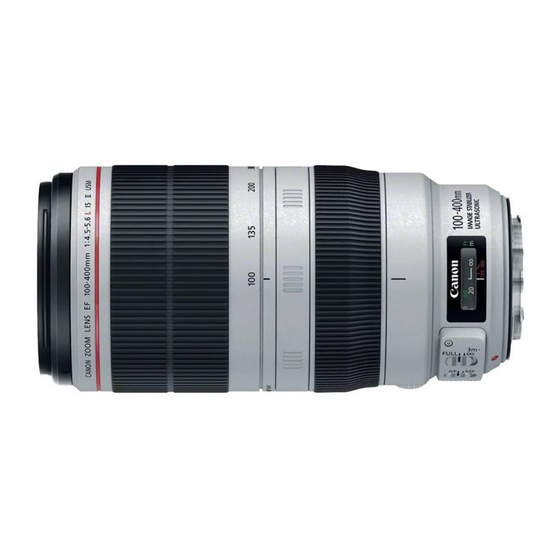Table of Contents
Advertisement
Advertisement
Table of Contents

Summary of Contents for Canon RF 100-400mm F5.6-8 IS USM
- Page 1 Instructions...
-
Page 2: Camera Firmware
Thank you for purchasing a Canon product. Canon RF100-400mm F5.6-8 IS USM is a Camera Firmware telephoto zoom lens for use with EOS R series cameras. Please use the latest version of firmware with the camera in use. For details on whether the firmware is the latest version or not, and for details on updating “IS”... -
Page 3: Safety Precautions
Safety Precautions Precautions to ensure that the camera is used Details pertaining to risks that Caution safely. Read these precautions thoroughly. Make may result in injury or damage to sure all details are observed in order to prevent other objects. risks and injury to the user and other people. -
Page 4: General Precautions
General Precautions Handling Precautions Do not leave the product in excessive heat such as in a car in direct sunlight. High temperatures can cause the product to malfunction. If the lens is taken from a cold environment into a warm one, condensation may develop on the lens surface and internal parts. - Page 5 This device complies with Part 15 of the FCC Rules. CAN ICES-3 (B) / NMB-3 (B) Operation is subject to the following two conditions: (1) This device may not cause harmful interference, and (2) this device must accept any interference received, including interference that may cause undesired operation.
- Page 6 Nomenclature Focusing ring (→7) Zoom ring (→8) Control ring (→10) Zoom position index (→8) Hood mount (→13) Zoom ring lock lever (→9) Filter mounting thread (→15) Contacts (→6) Lens mount (→6) Focus mode switch (→7) Lens mount index (→6) Image stabilizer switch (→11) F or detailed information, reference page numbers are provided in parentheses (→ **).
-
Page 7: Attaching The Lens
1. Attaching and Detaching the Lens Lens mount index Set the camera’s power switch to OFF when attaching or detaching the lens. Attach the lens cap before detaching the lens from the camera. After detaching the lens, place the lens with the rear end up and attach the dust cap to prevent the lens surface and contacts from getting scratched. -
Page 8: Setting The Focus Mode
2. Setting the Focus Mode Focusing ring The lens’ focusing ring is electronic. With a camera capable of electronic full-time manual focus, manual focusing is always possible whenever camera operations are possible. However, this requires a change in camera settings. When AF operation is set to [ONE SHOT], manual focus is possible after autofocusing has been completed by continuing to press the... - Page 9 3. Zooming Be sure to finish zooming before focusing. Zooming after focusing can affect the focus. Once a close-up subject is in focus, zooming may cause the subject to come out of focus. In this instance, move back from the subject and refocus.
- Page 10 4. Fixing the Zoom Ring The zoom ring can be fixed to keep the lens at the shortest point. This function is convenient for carrying a camera on a strap because it prevents the lens from extending. Turn the zoom ring to Slide the zoom ring lock the wide end position lever in the direction...
-
Page 11: Control Ring
There are cases in which the sound of control ring operations may be recorded when shooting movies. The clicking sensation of the control ring can be removed by the Canon Service Center. (chargeable) ENG-10... -
Page 12: Image Stabilizer
6. Image Stabilizer The Image Stabilizer cannot compensate for a blurred shot caused by a subject that moved. The Image Stabilizer may not be fully effective if you shoot from a violently shaking vehicle or other transportation. If using a camera that allows you to change the shutter mode setting, [Elec. - Page 13 Image Stabilizer The Image Stabilizer for this lens is suited to hand-held shots in the following conditions. In semi-darkened areas such as indoors or outdoors at night. In locations where the flash cannot be used, such as art museums and theater stages. In situations where your footing is uncertain.
-
Page 14: Attaching The Hood
7. Hood The custom lens hood reduces unwanted light that causes flare and ghosting and protects the front of the lens from rain, snow, and dust. Attachment position mark Red dot Button Red dot Red dot Detaching the Hood Attachment position mark Stop position mark Keep your finger pressed down on the button located on the side of the hood, and then turn... - Page 15 The range-finding area for this lens will differ depending on the combination of camera and extender in use. Please check the Canon website for further details. When an extender is attached, the AF speed will become slower to retain proper control.
- Page 16 You can attach filters to the filter mounting thread on the front of the lens. Only one filter may be attached. If you need a polarizing filter, use the Canon Circular Polarizing Filter PL-C B. Detach the hood when adjusting the polarizing filter.
-
Page 17: Specifications
Specifications Focal Length/Aperture 100 - 400mm f/5.6 - 8 Lens Construction 9 groups, 12 elements Maximum Aperture f/5.6 - 8 Minimum Aperture f/32 - 45 Angle of View Horizontal: 20° - 5°10’, Vertical: 14° - 3°30’, Diagonal: 24° - 6°10’ Min. - Page 18 The maximum diameter, length and weight listed are for the lens itself only. Close-up Lens 250D/500D cannot be attached because there is no size that fits the lens. All data listed is measured according to Canon standards. Product specifications and appearance are subject to change without notice.
- Page 19 CT1-D200-A 2106SZ © CANON INC. 2021...












